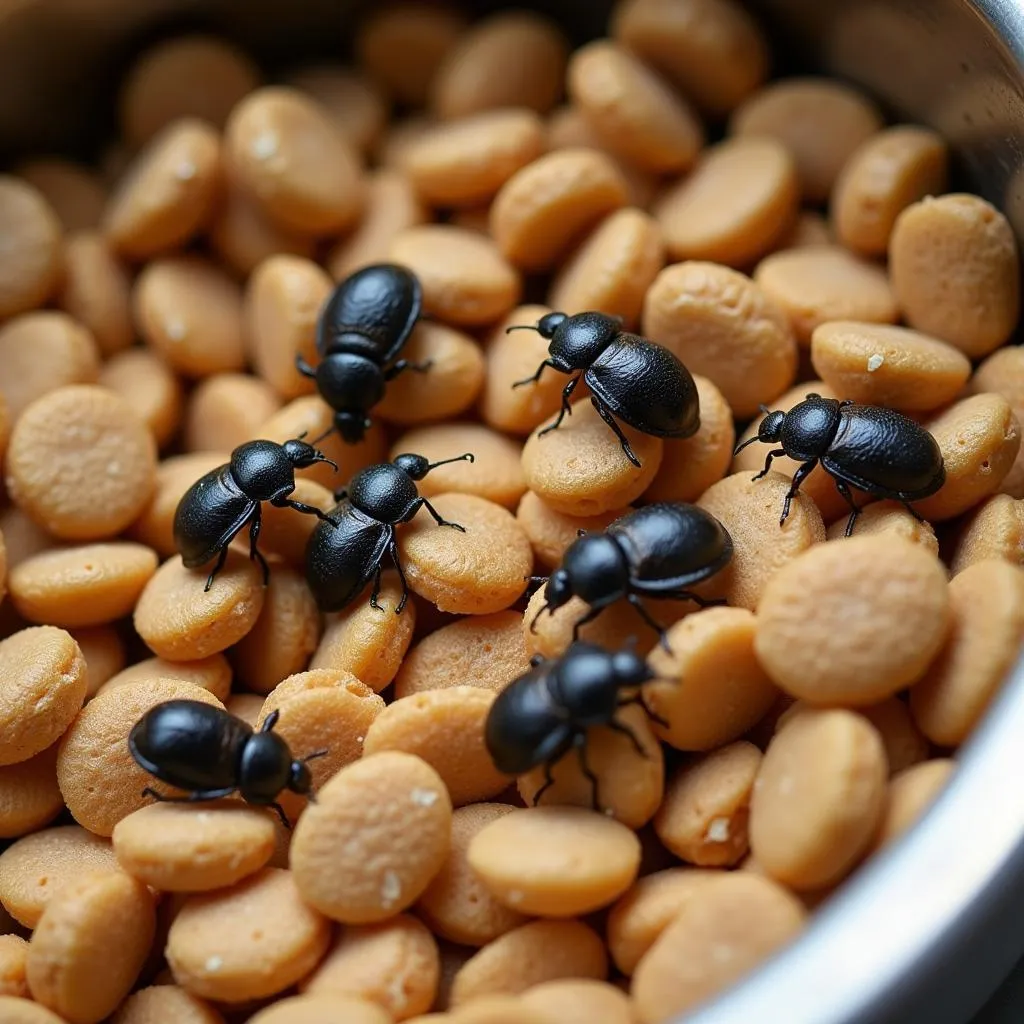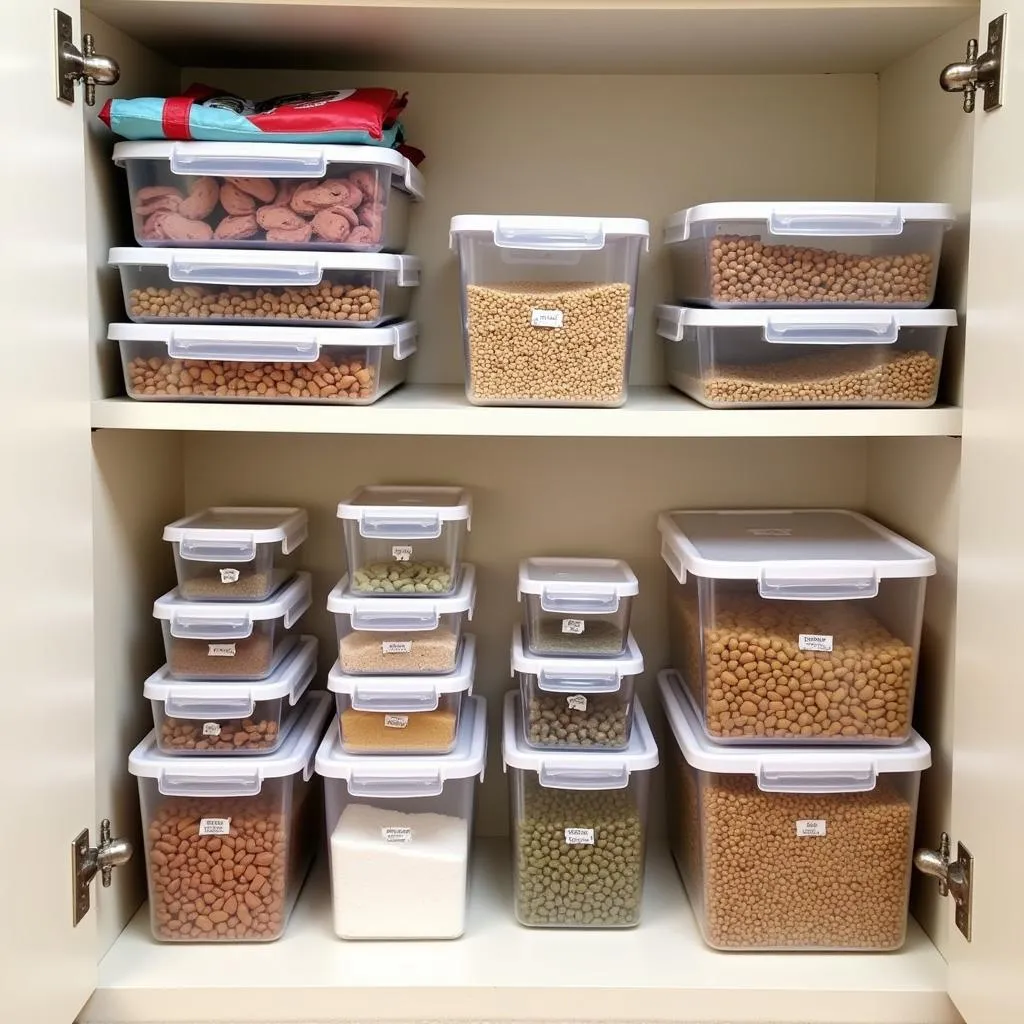Finding little black bugs in your dog’s food can be alarming. You want to ensure your furry friend is eating safe and nutritious food, and the presence of any insects can be concerning. This article will explore the common culprits behind those pesky critters, discuss the potential risks they pose, and guide you on how to prevent future infestations.
 Close-up of black bugs in dog food
Close-up of black bugs in dog food
Identifying the Tiny Intruders
Before you hit the panic button, it’s crucial to identify the type of bugs you’re dealing with. While some insects might be harmless, others can indicate a serious problem. Here are some common culprits:
1. Weevils: These tiny, reddish-brown to black beetles are notorious pantry pests and can easily infest stored grains, including dog food. They have a characteristic elongated snout and typically lay their eggs inside the kibble.
2. Flour Beetles: As their name suggests, flour beetles are attracted to flour-based products but can also infest pet food. They are small, reddish-brown beetles with a flattened body shape.
3. Grain Mites: These microscopic creatures are barely visible to the naked eye and appear as moving dust particles in dog food. They thrive in warm, humid environments and can multiply rapidly.
 Chart illustrating different types of pantry bugs
Chart illustrating different types of pantry bugs
Are These Bugs Harmful to Your Dog?
The good news is that most pantry bugs found in dog food are not directly harmful to your pet. They are unlikely to cause poisoning or transmit diseases. However, that doesn’t mean you should ignore them.
Here’s why:
- Palatability Issues: Bugs can alter the taste and smell of dog food, making it unappetizing for your furry companion. This can lead to decreased appetite and potential nutritional deficiencies if your dog refuses to eat.
- Spoilage and Mold Growth: Insect infestations often indicate a breach in the packaging, which can expose the dog food to moisture and air. This creates an ideal environment for mold growth, which can be harmful to your dog’s health.
- Allergic Reactions: While rare, some dogs might be allergic to certain insects or their byproducts, leading to skin irritation, gastrointestinal upset, or other allergic reactions.
Preventing Bug Infestations: Keeping Your Dog’s Food Safe
The key to preventing bug infestations is to eliminate their food source and create an environment where they can’t thrive. Here are some proactive steps you can take:
- Store Dog Food Properly: Always store dog food in airtight containers made of sturdy plastic or metal. This will prevent bugs from entering and keep the food fresh.
- Keep It Clean and Dry: Store dog food in a cool, dry place, ideally off the floor. Wipe down storage areas regularly to remove crumbs and spills that can attract insects.
- Inspect New Bags: Before pouring dog food into the storage container, inspect the bag thoroughly for any signs of damage, tears, or insects.
- First In, First Out: Use older bags of dog food before new ones to ensure freshness and minimize the risk of infestations.
- Clean Bowls Regularly: Wash your dog’s food and water bowls with hot, soapy water after each use to eliminate food residue that can attract bugs.
- Freeze for 24 Hours: As an extra precaution, you can freeze new bags of dog food for 24 hours to kill any potential insect eggs.
 Dog food stored in airtight containers
Dog food stored in airtight containers
What to Do if You Find Bugs
If you discover bugs in your dog’s food, don’t panic! Here’s what you should do:
- Discard the Infested Food: Dispose of the entire bag or container of infested food, even if it appears that only a small portion is affected.
- Clean Thoroughly: Clean the storage area where the infested food was kept, including shelves, walls, and floors. Vacuum thoroughly to remove any stray insects or eggs.
- Contact the Manufacturer: Inform the dog food manufacturer about the infestation. They may offer a replacement product or provide advice on how to prevent future issues.
- Monitor Your Dog: Observe your dog for any unusual symptoms like vomiting, diarrhea, loss of appetite, or skin irritation. If you notice any concerning signs, consult your veterinarian.
Conclusion
While discovering little black bugs in your dog’s food is certainly unpleasant, it’s usually not a cause for major alarm. By following the preventative measures outlined in this article, you can significantly reduce the risk of infestations and ensure your furry friend enjoys safe and delicious meals.
Remember, a clean and organized pantry is a happy pantry – for both you and your four-legged companion!
FAQs
1. Can I still feed my dog food with dead bugs in it?
It’s best to err on the side of caution and discard any food that has had insects in it.
2. How often should I clean my dog’s food storage containers?
Aim to clean them with hot, soapy water every 1-2 months, or more frequently if you notice any spills or crumbs.
3. Do I need to throw away unopened bags of dog food if I find bugs in one bag?
As a precaution, it’s best to inspect all unopened bags thoroughly and consider freezing them for 24 hours to kill potential insect eggs.
4. Are there any specific dog food brands that are more susceptible to bug infestations?
Insect infestations can happen with any brand, but those containing grains and starches might be slightly more susceptible.
5. What should I do if my dog ate food with bugs in it and is showing signs of illness?
Contact your veterinarian immediately and bring a sample of the contaminated food, if available.
Need further assistance? Our dedicated customer support team is here to help! Reach us at:
Phone: 02437655121
Email: minacones@gmail.com
Address: 3PGH+8R9, ĐT70A, thôn Trung, Bắc Từ Liêm, Hà Nội, Việt Nam.
We’re available 24/7 to answer your questions and provide expert advice!